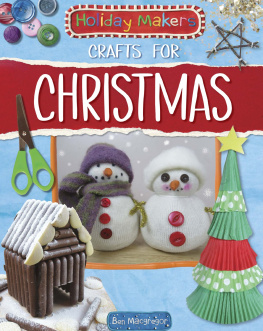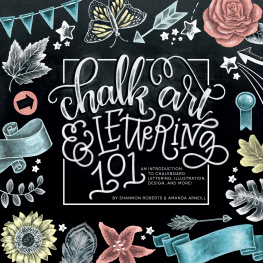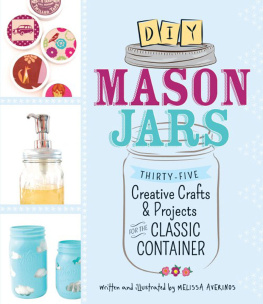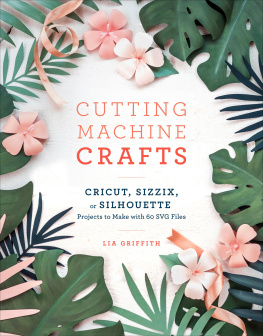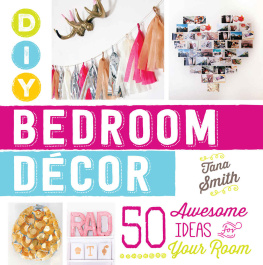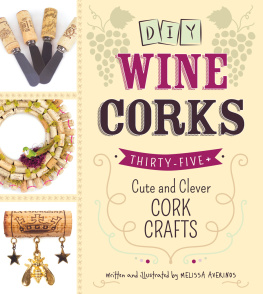Introduction
From weddings to birthday parties, playrooms to kitchens, chalkboards seem to be popping up anywhere and everywhere lately. As chalkboard paint has become widely available and inexpensive, its popularity has exploded and for good reason. It is easy to use and versatile. It can allow you to release your inner creative genius on almost any household object. If youre like me and you have a child or a couple of children, youll find chalkboard paint provides an endless source of fun and entertainment for the kids.
This book is filled with chalkboard projects both big and small and will guide and hopefully inspire you to use chalkboard paint elsewhere around your home. Browse the tips and techniques chapter to find out how to achieve beautiful results when working with chalkboard paint. The tools of the trade section will list some of the essential tools you will need to get these projects done. Each project tutorial includes a detailed supply list and set of directions as well as additional decoration ideas, tips, and/or advice on how to take the project even further.
If youve never used chalkboard paint before, why not start with a quick and easy project, such as the paperweight, coasters, or napkin rings? These are sure to give you success and results you can be pleased with. Once youve mastered the basic techniques of using chalkboard paint, you can move on to bigger, more involved projects, such as the shadow box, table runner, or menu board. Orand this is the really great part!design a project of your own.
However you decide to use this book, I hope it sparks creativity in you so that you can make chalkboard projects for your home, your loved ones, and for yourself.
How to Use This Book
In this book, you will find seven chapters dedicated to chalkboard paint. The first chapter, Paint Like a Pro! Tips and Techniques for Working with Chalkboard Paint, gives you some tips and dos and do nots for using chalkboard paint as well as an overview of some of the supplies you will need for most of the projects. The remaining chapters, Around the Home, Crafts with Children, Celebratory Creations, Outdoor Undertakings, The Organized Chalkboard, and Holiday Fun, give directions on how to create more than fifty big or small projects and incorporate the goodness that is chalkboard paint into them. Some of the projects are quick and easy and will require just a little bit of chalkboard paint. Others are a bit more involved and will require a little bit of elbow grease and some power tools, but will leave you with stunning results. Lets get started, shall we?
CHAPTER ONE
Paint Like a Pro! Tips and Techniques for Working with Chalkboard Paint
Painting with chalkboard paint is easy; even children can do it (with proper supervision, of course). All you need are a few tips and techniques, the right tools of the trade, and a dollop of inspiration. Since chalkboard paint can be used on almost any smooth surface, the possibilities are almost endless! Be creative and use your imagination in these projects to transform those ordinary objects in your home. Also, use this book as a guide to creating your own chalkboard projects. Pick and choose what you like from this book, put your own spin on the projects, and most importantly, have fun!
General Tips and Techniques
Chalkboard paint can be used on almost any surface: wood, metal, glass, ceramic, clay, fabric, porcelain, plaster, cardboard, terra cotta, canvas, papier-mch, and plastic. Always begin with a clean, dry surface. A vacuum and tack cloths remove almost all dust and debris from a surface. If youve never used chalkboard paint before, here are some general guidelines. Note that for best results, you should always follow the directions found on the label of your chalkboard paint. In addition, follow these guidelines:
- Smooth, flat surfaces provide the best places to apply chalkboard paint. Do not apply chalkboard paint to bumpy or rough surfaces.
- If painting on wood, make sure the surface is smooth before painting. Sand the surface beginning with a coarser-grit sandpaper, such as 120 grit, working your way up to 220-grit sandpaper if necessary.
- Priming plastics, metals, and bare wood before using chalkboard paint will decrease the likelihood of the paint chipping, flaking, or scratching off.
- If youre using primer, use the correct kind for your surface. (For example, use primer intended for metal for metal surfaces and plastic primer for plastic surfaces.)
- If using multisurface chalkboard paint on fabrics, always prewash the fabric with soap and water. Allow it to dry thoroughly before applying the paint. Testing a small section of the fabric before initial use is always a good idea. Chalkboard paint will not adhere to all fabrics, so read the instructions on the label before proceeding.
- Painters tape will give you crisp, clean edges and help prevent any paint from leaking onto surfaces that you wish to remain paint free. Always remember to firmly press the tape down before painting. I find that FrogTape works best for any paint project.
- Should any paint accidently leak under your painters tape, scrape it off the surface with a razor blade.
- All chalkboard paints are not created equal, especially when it comes to drying times. Be sure to read the manufacturers instructions on the labels of your chalkboard paint to learn about waiting time in between coats of paint as well as how long it will take the paint to cure before you can season it. Some chalkboard paint will require the surface to cure for 24 hours before initial use.
- Always season a chalkboard surface before writing on it for the first time. To season a chalkboard, rub a piece of white chalk over the entire surface and then erase it. Do not use a chalk marker or colored chalk to season a chalkboard surface.
- If you want your writing to last a bit longer and not rub off so easily, use a chalk marker instead of a regular piece of chalk. To remove chalk marker from a chalkboard surface, use a damp paper towel or rag.
- When creating chalkboard-paint projects for children, make sure they dont contain anything harmful to babies or toddlers if they put them in their mouths. Most chalkboard paint is nontoxic, but it is better to be safe than sorry!
Dont limit yourself to the basic black or green chalkboard colors. There are many colors of chalkboard paint available in craft and home improvement stores. You can also have chalkboard paint tinted to almost any color, making it useable in any color scheme in your home. So go wild!
There are many resources in books and on the Internet for making your own chalkboard paint. This isnt discussed in this book, but you might want to research and try it for yourself!
Tips on Using Brush-On Chalkboard Paint
There are two basic ways to apply chalkboard paint to a surface: brushing and spraying. Here are some tips about brush-on paint:
- Follow all instructions found on the label before beginning any paint project.
- Before using brush-on chalkboard paint, stir the paint well with a paint stick. To prevent any bubbles, avoid shaking the paint or stirring too vigorously.


